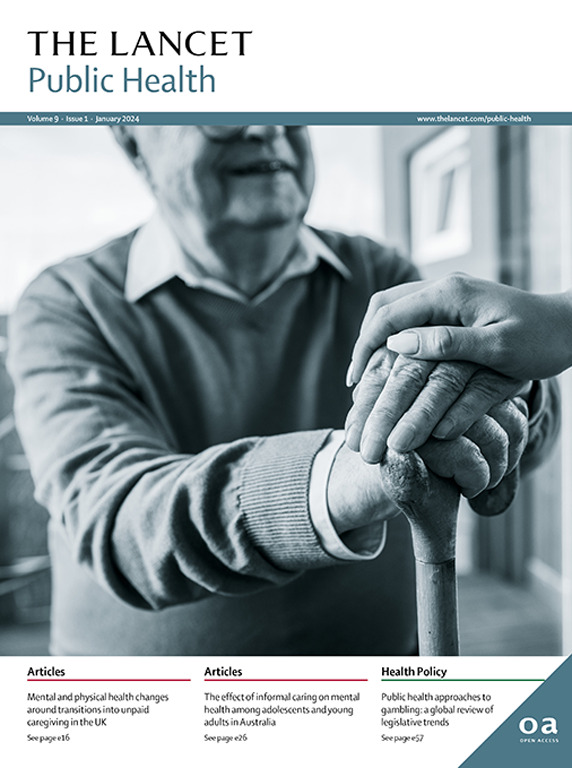2001-22年英格兰酒精相关死亡趋势:一项观察性研究
IF 25.4
1区 医学
Q1 PUBLIC, ENVIRONMENTAL & OCCUPATIONAL HEALTH
引用次数: 0
摘要
背景在 COVID-19 大流行之后,许多国家的酒精致死率大幅上升,英格兰也不例外。本研究旨在探讨按特定死因、年龄、性别和地区贫困程度划分的死亡者特征是否发生了变化。方法利用国家统计局发布的英格兰年度死亡率数据,我们描述了2001年至2022年期间,按年龄、性别、地区贫困程度(以多重贫困指数(IMD)的五分位数衡量)和死因划分的酒精特定死亡率的总体流行率和年龄标准化率的95% CI。我们还比较了 COVID-19 大流行之前(2017-19 年)和之后(2020-22 年)死亡者的人口统计学特征;计算了不同年龄、性别和 IMD 死亡率的粗略绝对差异和相对比率比;并使用多变量泊松回归模型计算了每个时期 IMD 五分位数的死亡率比和调整后的绝对差异,同时对年龄和性别进行了调整。研究结果英格兰酒精特异性死亡的年龄标准化比率在2019年之前基本保持不变,2020年急剧上升19-4%,2022年继续上升13-5%,达到有记录以来的最高水平:每10万人14-7(95% CI 14-4-15-0)。在2017-19年(大流行前)和2020-22年(COVID-19大流行开始后)之间,酒精特异性死亡率的相对人口变化不大,因为酒精特异性死亡率绝对值增长最大的是大流行前死亡率最高的群体,包括男性(绝对值增长3-87;相对值增长25-9%)和来自贫困程度较高地区的人群(绝对值增长4-72;相对值增长22-5%)。在研究死亡原因时,绝对增长率最大的是酒精相关肝病(2-37;相对增长率,27-2%),相对增长率最大的是急性病(绝对增长率,0-49;相对增长率,35-4%),尽管与酒精相关肝病相比,急性病所占的死亡比例较小。酒精依赖综合征导致的死亡几乎没有变化(绝对死亡率增加了 0-02;相对死亡率增加了 5-8%)。相关政策应旨在降低人口的酒精消费率。还需要大量投资,以促进肝病的早期发现和有效治疗。本文章由计算机程序翻译,如有差异,请以英文原文为准。
Trends in alcohol-specific deaths in England, 2001–22: an observational study
Background
Following the COVID-19 pandemic, many countries saw large increases in rates of alcohol-specific deaths, including England. This study aimed to examine whether there have been changes in the characteristics of those dying by specific cause of death, age, sex, and area-level deprivation.Methods
Using annual mortality data in England published by the Office for National Statistics, we describe the prevalence and 95% CI of age-standardised rates of alcohol-specific deaths overall and by age, sex, area-level deprivation measured by quintiles of the Index of Multiple Deprivation (IMD), and cause of death between 2001 and 2022. We also compared demographic profiles of those dying before the COVID-19 pandemic (2017–19) and after (2020–22); calculated crude absolute differences in rates and relative rate ratios across age, sex, and IMD; and used a multivariable Poisson regression model to calculate the rate ratio and adjusted absolute differences for deaths by IMD quintile for each period, adjusting for age and sex.Findings
Age-standardised rates of alcohol-specific deaths in England remained largely unchanged until 2019, before rising sharply by 19·4% in 2020 and continuing to rise by a further 13·5% to the highest level on record in 2022: 14·7 (95% CI 14·4–15·0) per 100 000 people. There were few relative demographic changes in alcohol-specific mortality between 2017–19 (pre-pandemic) and 2020–22 (after the start of the COVID-19 pandemic) because the largest absolute increases in alcohol-specific mortality were seen among groups that had the highest pre-pandemic rates, including men (absolute rate increase, 3·87; relative increase, 25·9%) and those from areas of higher deprivation (absolute rate increase, 4·72; relative increase, 22·5%). When examining causes of deaths, the largest absolute increase was in alcohol-related liver disease (2·37; relative increase, 27·2%), with the largest relative increase in acute causes (absolute rate increase, 0·49; relative increase, 35·4%), although these accounted for a smaller proportion of deaths compared to alcohol-related liver disease. There was little to no change in deaths from alcohol dependence syndrome (absolute rate increase, 0·02; relative increase, 5·8%).Interpretation
Alcohol-specific deaths in England remain high and increased after the COVID-19 pandemic. Policies should aim to reduce rates of alcohol consumption at the population level. Substantial investment is also required to facilitate early detection of liver disease and effective treatment.Funding
Cancer Research UK求助全文
通过发布文献求助,成功后即可免费获取论文全文。
去求助
来源期刊

Lancet Public Health
Medicine-Public Health, Environmental and Occupational Health
CiteScore
55.60
自引率
0.80%
发文量
305
审稿时长
8 weeks
期刊介绍:
The Lancet Public Health is committed to tackling the most pressing issues across all aspects of public health. We have a strong commitment to using science to improve health equity and social justice. In line with the values and vision of The Lancet, we take a broad and inclusive approach to public health and are interested in interdisciplinary research.
We publish a range of content types that can advance public health policies and outcomes. These include Articles, Review, Comment, and Correspondence. Learn more about the types of papers we publish.
 求助内容:
求助内容: 应助结果提醒方式:
应助结果提醒方式:


